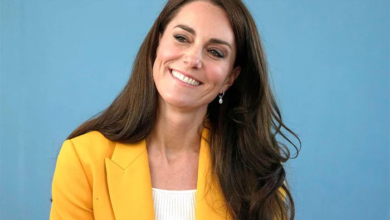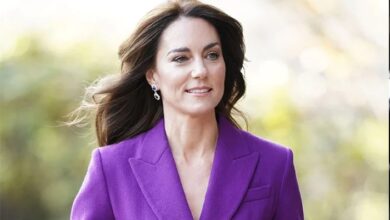Princess Kate Middleton Never Had Cancer As New Report Stirs Controversy

Princess Kate Middleton has recently become the focus of a surprising and heated online debate, with some questioning the authenticity of her reported cancer diagnosis.
Speculation surrounding her health has been fueled by statements made by respected royal journalist Rhiannon Mills and has prompted a surge of conspiracy theories.
The Princess of Wales, who announced in March that she was diagnosed with cancer after “major abdominal surgery” in January, revealed in September that she had completed chemotherapy and was now “cancer-free.”
However, recent reports are suggesting that her diagnosis may have been less serious than initially perceived, sparking a flood of rumors and debate across social media.
The speculation around Kate’s diagnosis originated with a New York Post report citing statements made by Rhiannon Mills, the senior royal editor at Sky News, who noted that Kate had been diagnosed with “pre-cancerous cells” rather than an active, invasive cancer.
Mills’ report, which described her treatment as a preventive measure rather than an immediate response to cancer, has triggered widespread debate and questioning about the nature of her condition.
“In March, the princess confirmed that pre-cancerous cells had been found following abdominal surgery and that she would have to undergo a course of preventative chemotherapy,” Mills wrote in an article published in September.
This wording—particularly the use of the term “pre-cancerous cells”—sparked a wave of doubt, leading some to wonder if the princess’s treatment was preventive rather than curative.
Mills, a well-respected journalist and member of the royal rota, lent credibility to the speculation simply by raising the question, and neither the palace nor Middleton herself has issued a clarification or correction to date.
The term “pre-cancerous cells” is medically significant, as it generally refers to abnormal cells that have the potential to become cancerous but are not cancerous at the time of detection.
A medical expert who spoke with The Daily Beast pointed out that “pre-cancerous cells” and “cancer” are not interchangeable.
“You either have pre-cancerous cells, or you have cancer; the two terms are not interchangeable,” said the expert.
This medical distinction has added fuel to the debate, as some now believe Kate may have undergone treatment as a preventative measure rather than fighting an active form of cancer.
British pundit Narinder Kaur took to social media to share her thoughts on the controversy, adding further attention to the conversation.
In a post on X, formerly known as Twitter, Kaur wrote, “I don’t know if she had cancer or pre-cancer cells. But either way…I’ve been attacked in the most vicious way. Just because I asked why she looked aged. Just THAT.”
Kaur’s comment drew a wave of responses, both critical and supportive, as the public engaged in the ongoing discussion about Kate’s health.
Kate’s official announcement about her diagnosis came in March, just two months after her reported abdominal surgery at the London Clinic.
Following her surgery, Kate disclosed that she would undergo chemotherapy. By September, she confirmed that her treatment had ended, and she was reportedly “cancer-free.”
However, the palace’s silence on the details has left the door open to interpretation, with some royal watchers questioning the transparency of the announcement.
The palace’s lack of clarification on Mills’ statement has left a gap in public understanding, and, as a result, various conspiracy theories have taken root.
Theories range from questioning the gravity of Kate’s illness to suggesting that the cancer diagnosis was not accurately represented to the public.
The controversy has been met with significant backlash from both sides: while some accuse critics of being insensitive and overly invasive, others argue that the public deserves transparency about a matter that has received significant media coverage.
The debate also underscores a growing tension between the royal family’s desire for privacy in personal matters and the public’s interest in understanding the lives of figures who represent the British monarchy.
Read More: Kate Middleton Received Harsh Comment About Her Looks Which Stirs Online Backlash
In a post-pandemic world, where transparency around health issues has become more common, some royal watchers argue that public figures should provide clearer communication about health issues that are widely publicized.
Kate has always been a highly respected figure within the royal family, known for her resilience, grace, and dedication to her duties.
Her reputation for privacy, however, has occasionally caused friction with some members of the media and the public who seek more access to her personal life.
This latest controversy highlights the challenge faced by public figures like Kate, who must balance public curiosity with their right to privacy.
Meanwhile, conspiracy theories continue to grow online, as people comb through past appearances and comments looking for hints about the true nature of her condition.
The lack of an official response from the palace is being interpreted by some as a sign that the original report from Mills may hold some truth, while others insist that privacy around such sensitive matters should be respected, especially considering Kate’s prominent role in the public eye.
The situation has also raised questions about the role of media coverage in royal health matters.
Royal reporters, particularly those on the royal rota, are tasked with covering both the official and personal aspects of the monarchy’s lives, but it is a fine line to walk.
Any perceived inconsistency or lack of clarity from such sources is often seized upon by conspiracy theorists, which can lead to significant public discourse and even online harassment.
In the end, Kate Middleton’s journey through her reported cancer diagnosis, whether preventative or otherwise, remains a private matter for the princess.
As speculation continues, it is evident that her health will remain a focal point for royal watchers and a lesson in the challenges of balancing public curiosity with personal privacy.
The palace may yet choose to issue a clarification, but until then, the debate over the nature of her diagnosis serves as a reminder of the pressures faced by public figures, particularly those within the royal family.






